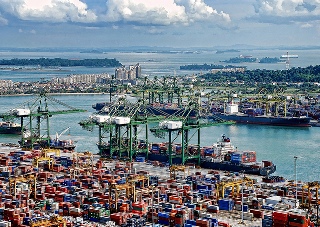 The lucrative intra-Asia routes are shaping up to be the prize in an emerging tug-of-war between global carriers wanting a bigger slice of the market and regional players forming defensive alliances against the big boys.
The lucrative intra-Asia routes are shaping up to be the prize in an emerging tug-of-war between global carriers wanting a bigger slice of the market and regional players forming defensive alliances against the big boys.
In its latest report, Drewry Maritime Research said financially troubled deep-sea ocean carriers are “increasingly seeking salvation in the intra-Asia market due to higher than usual cargo growth and the availability of cheap vessel charter rates.”
It noted that at least one new regional service is launched almost on a monthly basis, some of which now deploy vessels of over 4,000 twenty-foot-equivalent units (TEUs).
Examples include the Maersk-owned MCC Transport and NYK’s weekly Japan-China-Thailand schedule launched in March, and NYK, “K” Line, and Hapag-Lloyd’s Japan-SE Asia service that deploys four 4,200-TEU vessels.
Cosco, meanwhile, has joined PIL, Yang Ming, and Wan Hai in a service calling at Xingang, Dalian, Shanghai, Fuzhou, Hong King, Singapore, Port Klang, Penang, Singapore, Hong Kong, and Xingang. The service deploys four vessels averaging 4,300 TEUs.
There is money to be made out of such services, as evidenced by Wan Hai’s financial performance since 2009, said Drewry. Last month the intra-Asia specialist reported impressive financial results for the first quarter of the year, and has consistently outperformed many of its peers since 2009 in extracting operating profit out of every dollar earned despite not having their economies of scale.
And OOCL captured 53 percent of its total traffic from the intra-Asia market in the first quarter of the year, and saw the region, including Asia/Australia, as its fastest growing market in the same period.
Measuring the way that intra-Asia routes have been growing is difficult, as there are many different trade lanes, and no centralized data source. Moreover, there are many routes served by shuttle services deploying vessels no bigger than 500 TEUs because of draught restrictions.
According to the Intra Asia Discussion Agreement (IADA), its member-lines alone shipped 7.2 million TEUs on the routes in 2013, about 9 percent more than in 2012.
“To put this in perspective, that is more cargo than was shipped between Europe and the whole of North America in 2013 (6.7 million TEUs), and over double its annual growth rate of 4.3 percent,” said Drewry.
IADA members include 11 of the top global deep-sea carriers (but excluding MSC and the three big Japanese lines), as well as a number of regional specialists.
The intra-Asia market is clearly competitive, as evidenced by the forced withdrawal of Swee Joo, Yanghai Shipping, Grand China Shipping, STX Pan Ocean, and Hainan PO Shipping since the beginning of 2012. These intra-Asia fatalities deployed vessels mostly below 1,000 TEUs.
Wan Hai currently deploys 72 vessels averaging 2,400 TEUs, ranging between 640 TEUs and 5,500 TEUs, which explains why deep-sea carriers are now interested in the market, spurred on by the ready availability of cheap charter vessels.
Not surprisingly, regional players are joining forces to compete more effectively against the incursions of bigger players, to try to limit further capacity growth in certain key trades, said Drewry.
Last month Sinotrans, Pan Asia Shipping (intra-Asian arm of Coscon), and Shanghai Puhai Shipping (intra-Asian arm of CSCL) formed an operating alliance on services run between China and Japan.
And China’s SITC Container Lines and Shanghai Hai Hua Shipping have agreed to work more closely together between China and Japan.
“What this means for future freight rate levels remains to be seen, but there is much ground to recover already,” said Drewry. “Although 2013 was a difficult year for most carriers, many North-South services have been full since April, which has helped to increase rates. Northbound cargo growth of 12.5 percent from SE Asia to China in the first quarter of 2014 (y-o-y) was a particularly strong driver in this respect.
“Deep-sea ocean carriers will continue to use cheap charter rates to become further established in the intra-Asian market, and then use their own tonnage afterwards to squeeze out smaller competitors on routes where vessels over 2,000 TEUs can be safely deployed,” it continued. “Strong cargo growth is helping carriers to improve freight rates at the moment, but the supply/demand balance is fragile.”
Photo: Choo Yut Shing




